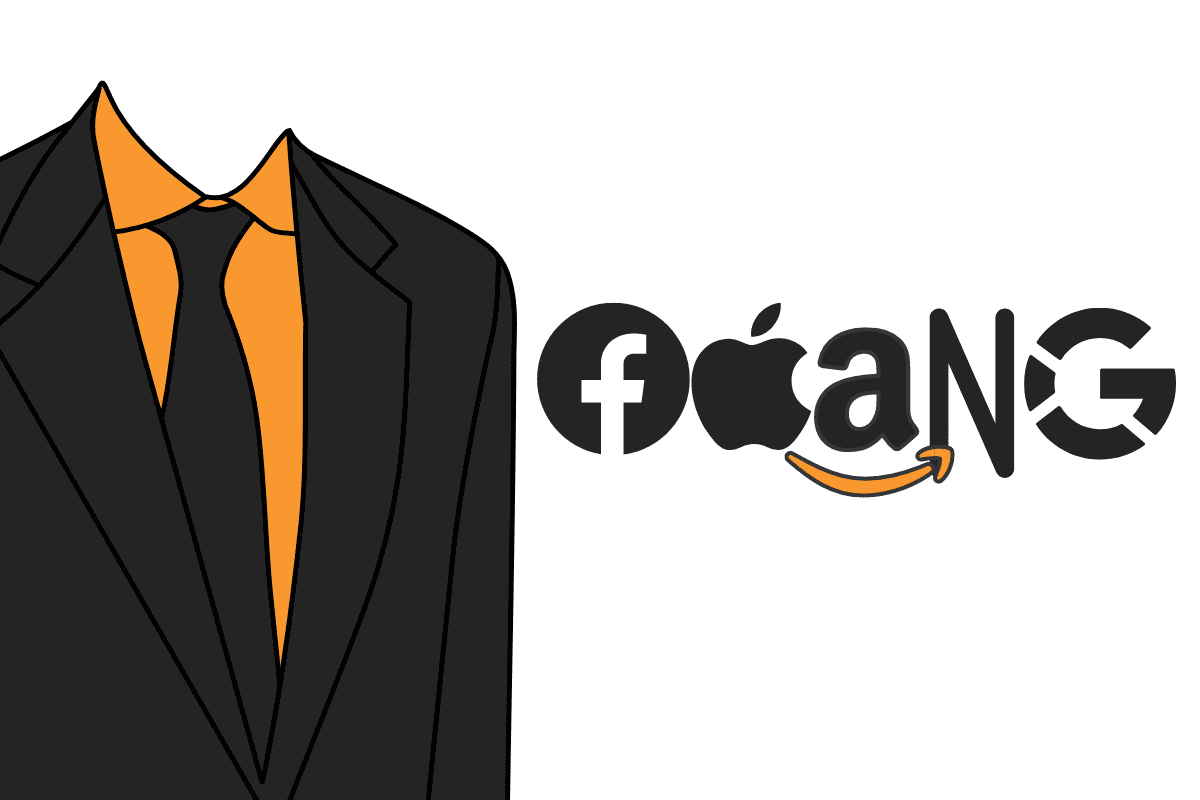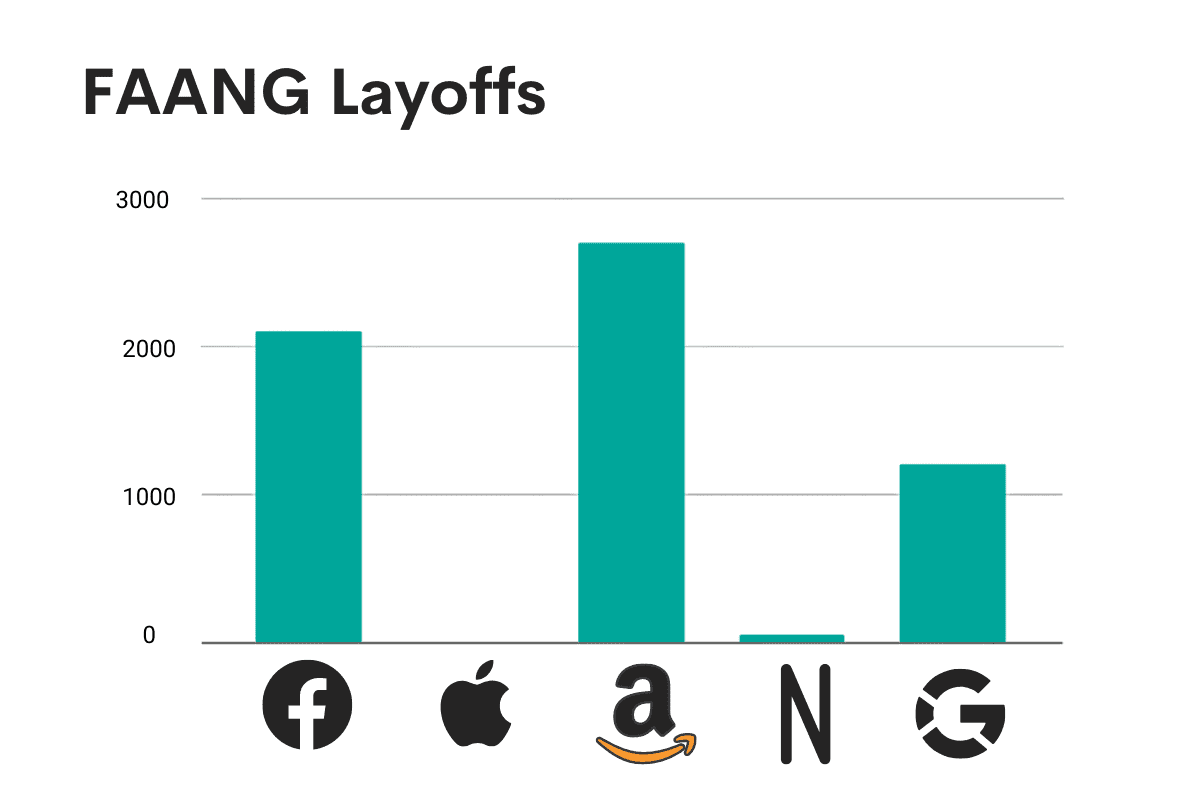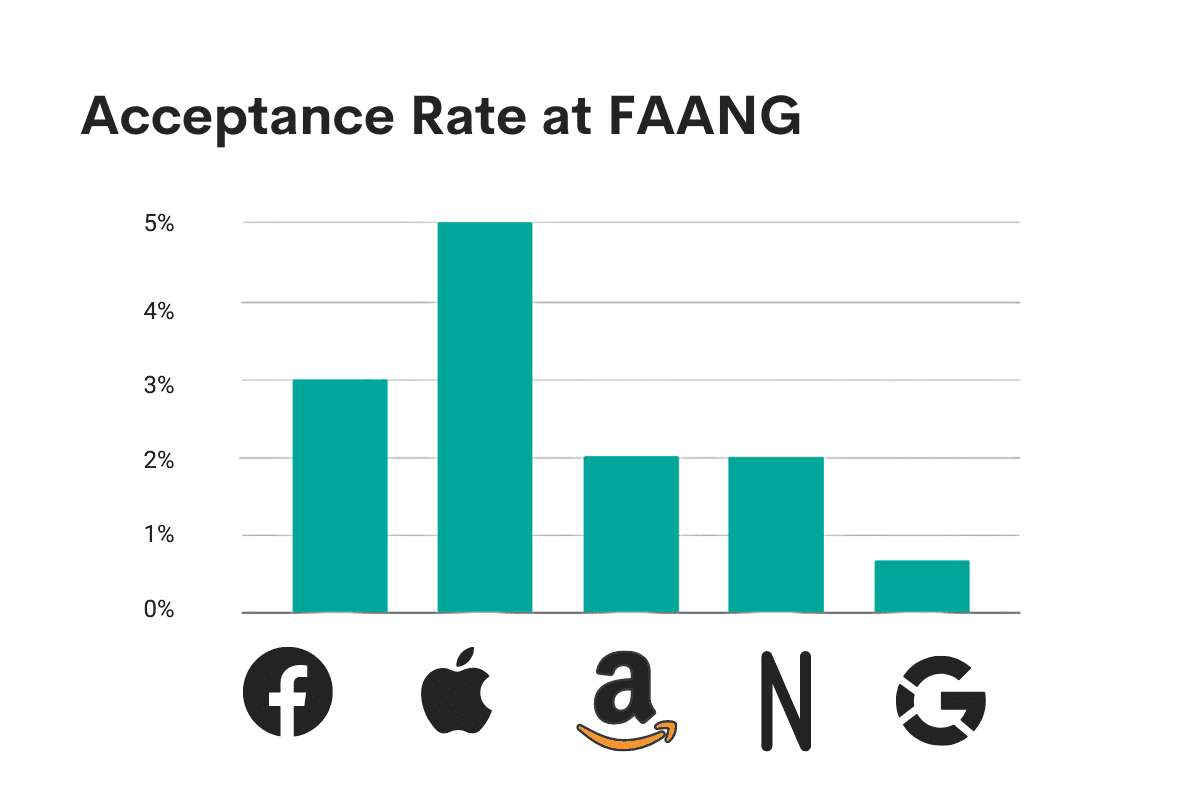How Hard is it to Get into FAANG Companies
This article explores the history and current state of FAANG companies, and how low acceptance rates for these companies may be due to the rapid growth of the tech industry.

Image by Author
Cue dramatic doom-and-gloom music. In the last two years, FAANG companies alone were responsible for over 50,000 layoffs (10,000 plus 11,000 from Meta; none from Apple; over 27,000 from Amazon in four separate batches; 500 from Netflix in four batches as well; and 12,000 from Google). What could that mean for the already-low acceptance rates for these companies? Just how tricky is it to get that acceptance letter from a FAANG company?

Image by Author
In this article, I’ll explore why getting a FAANG job is so hard in both a historic and current setting. I’ll also describe ways to increase your odds both for FAANG companies and others. Ultimately, it’s not as hard as you think. I’d also encourage you to broaden your perspective on getting accepted to a tech company.
What is FAANG?
I’m using FAANG here in two senses. First, you’ve got the companies responsible for the acronym: Facebook (now Meta), Apple, Amazon, Netflix, and Google (really Alphabet). The acronym was coined by CNBC’s Jim Cramer in 2013. Those companies were outperforming the broader market at the time, and FAANG caught on.
But it’s also useful to think of FAANG as a stand in for tech companies at large – think Microsoft, AirBnb, and Spotify. When I say FAANG has a low acceptance rate, what I really mean is that these big, loud tech companies are hard to get into, including Facebook, Amazon, Netflix, Apple, and Google, but also a lot of other flashy tech companies.
Overall, FAANG companies in both senses are known for rapid growth at all costs, dominant market positions, and innovative products. They attracted a lot of tech talent throughout the 2010s – applicants really thought they could help build products to make the world a better place.
Of course, in the depths of a tech winter here in 2023, it’s a different picture.
Just how low are your Odds?
There aren’t any official numbers on acceptance rates at FAANG, but I researched multiple articles that quote single digit percentage points (or less) for FAANG acceptances during these layoffs.
- Apple accepts a measly 3% of applicants.
- Facebook has a 5% acceptance past onsite interview, which means an even lower acceptance of all job applications.
- Amazon accepts less than 2%.
- Netflix accepted less than 2% of applicants in 2019. I got that number by dividing the total number of employees (6,800 in 2019) by the total number of applicants (350k). That means that even if every single position was refilled, the acceptance rate at netflix was still less than 2%. In reality, it was probably a lot smaller.
- Google accepted a positively miniscule 0.67%.

Image by Author
Now consider that, after 60k layoffs, these companies probably have tons of talented applicants and even fewer open positions.
Why is getting into FAANG Companies so Hard?
When I was applying to college, I was amazed that fewer than 1 in 20 applicants were accepted to universities like Yale, Princeton, and Brown. But FAANG acceptance rates put those to shame. Why is it so tough to get that acceptance letter?
Competition
When you apply to FAANG, you’re dealing with high competition. Everyone wants to work for FAANG or a FAANG adjacent company. Especially in the 2010s, FAANG had a very cool vibe – think ping-pong tables, free lunch, and other awesome perks in addition to job stability and a wildly high paycheck. Everyone with a lick of tech talent shot their shot.
High bar
FAANG has high standards. Thanks to the influx of applications, those tech companies could afford to only hire the creme de la creme of tech talent. Candidates were expected to have a glowing resume, amazing recommendations, and relevant education work experience – or a hell of a portfolio to make up for it.
Technical Interviews
FAANG companies and similar tech companies set up strict technical interviews. Even experienced engineers might falter when asked to do a whiteboard coding interview under the steely gaze of three hiring managers. It’s hard.
Here the article "Hiring in FAANG Companies and Knowing When You’re Ready", talks about the hiring process of FAANG companies.
Culture Fit
FAANG is picky about who they let in, beyond just coding know-how. Cultural fit is super important. Netflix didn’t want “brilliant jerks.” Apple only hired hard-core collaborators. Facebook wants forward-thinkers. So it’s not just about your resume, it’s about how you can prove that you’re a good “culture fit” for that company.
Those Numbers are Discouraging, but Misleading
Go back to those tiny little acceptance rate percentages. They’re miniscule, but misleading.
For one, it’s a different landscape nowadays. The heyday of big tech, for better or worse, has hit a rocky patch. FAANG companies are no longer universally recognized as the best to work at. As VC money dries up and they struggle to pivot profitably, salaries and perks can be just as good at smaller companies. Plus, it’s clear FAANG doesn’t offer any job reliability as they laid off 5-10% of their workforce in certain instances.
Furthermore, tech is still hiring, even if FAANG specifically has slowed down. ZipRecruiter found that 79% of laid-off tech workers had a new job within three months. Someone is still looking for top tech talent.
Finally, keep in mind that a vast number of applications to FAANG are basically junk. Like I said, everyone applies to FAANG because it’d be awesome to work there. But hiring managers are able to discard a huge number of those applications because they’re just not very good. Do a little bit of legwork. Networking can increase your chances tremendously. Attend a conference to meet people. Tailor your resume and cover letter for each application. That alone will help you stand head and shoulders above most FAANG applicants.
How to Increase your Chances of getting a Good Tech Job at FAANG or anywhere else

Image by Author
Yes, it’s hard to get accepted to these companies. But it’s not as hard as you think. Here are four ways to increase your chances of landing the tech job of your dreams, whether at FAANG or another great tech company.
Polish your Resume
You probably know this already, but it’s worth repeating that hiring managers at big tech companies automate a ton of job app searches. They match keywords to filter and discard tons of resumes and cover letters. Make sure yours matches the job posting as closely as possible, including relevant skills, experiences, and talents.
Practice the Interview
It’s critical to practice interview questions. Assuming you get the interview, you do not want to freeze up on that whiteboard. Make sure you’re up to date on the latest interview questions on a website like Stratascratch, so you can do as much prep beforehand as possible. Not only will this give you the skills you need to smash the interview, but the prep itself will soothe your nerves.
Build, deploy, repeat
In lieu of a degree or work experience, you need to prove you’ve got the chops that make you a good hire. Build and deploy projects that are interesting to you personally. Don’t just do the typical Kaggle competitions – hiring managers have seen that before. Go in on wild, wacky projects that allow you to tell the story of why big tech should hire you.
Go the extra mile
Finally, a good tip is to add libraries and packages to your resume. Applications for end users are a good and necessary place to start, but not many other tech applicants build libraries and packages. These help with:
- Demonstrating your deep understanding of software engineering and architecture.
- Showcasing something useful to a hiring manager.
- Gaining some traction on GitHub as a library, which can act as social proof.
There are plenty of other good interview practices, but those four tips are a good place to begin.
Look outside FAANG
I want to end this article by asking you to consider looking beyond FAANG as the end-all, be-all job provider. Today’s smaller startups can offer just as much salary, perks, job stability, and company culture as FAANG.
If nothing else, the massive layoffs prove that these big tech companies aren’t as stable or good as the 2010s led us to believe. Lots of great tech companies that didn’t overhire during the pandemic are looking for awesome candidates, so if you’re struggling to land a FAANG job, go for a smaller company first, prove yourself, and then reapply to FAANG with some work experience under your belt.
FAANG Companies are Tough to get into, but not too Hard
Ultimately, it’s hard to get into FAANG companies, there’s no question about that. But many applicants forget that it’s easier than you probably think, even in today’s current tech winter climate. All FAANG companies currently have tech job openings (Meta, Amazon, Apple, Netflix, and Alphabet respectively) and not only that, but tech companies as a whole are still hiring despite the chilly employment landscape.
To improve your odds, ensure your resume is as close to the job posting as possible. Practice interview questions until you’re blue in the face. Build, deploy, and build some more. And consider going that extra mile by including packages or libraries to your portfolio.
If you’re still having a hard time, you can always cast your employment search net further afield. Make sure you tailor each and every application, and don’t be afraid to hit that apply button. Tech companies will be lucky to have you, whether it’s at FAANG or another great organization.
Nate Rosidi is a data scientist and in product strategy. He's also an adjunct professor teaching analytics, and is the founder of StrataScratch, a platform helping data scientists prepare for their interviews with real interview questions from top companies. Connect with him on Twitter: StrataScratch or LinkedIn.
